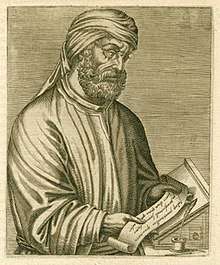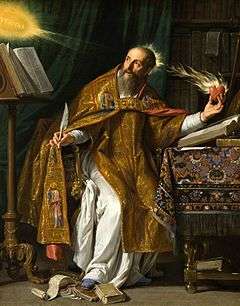Patristics
Patristics or patrology is the study of the early Christian writers who are designated Church Fathers. The names derive from the combined forms of Latin pater and Greek patḗr (father). The period is generally considered to run from the end of New Testament times or end of the Apostolic Age (c. AD 100) to either AD 451 (the date of the Council of Chalcedon)[1] or to the Second Council of Nicaea in 787.
Key persons
Prominent early Church Fathers whose writings form the basis for patristics comprise
- Ignatius of Antioch (c. 35 – c. 108)
- Pope Clement I (c. 1st century AD – c. 101)
- Polycarp of Smyrna (c. 69 – c. 155)
- Justin Martyr (c. 100 – c. 165)
- Irenaeus of Lyons (c. 120 – c. 202)
- Clement of Alexandria (c. 150 – c. 215)
- Tertullian (c. 160 – c. 225)
- Origen (c. 185 – c. 254)
- Cyprian of Carthage (d. 258)
- Athanasius (c. 296 – c. 373)
- Basil of Caesarea (c. 330 – 379)
- Gregory of Nazianzus (329 – 389)
- Gregory of Nyssa (c. 330 – c. 395)
- Jerome (347 – 430)
- Augustine of Hippo (354 – 430)
- Vincent of Lérins (d. bef. 450)
- Cyril of Alexandria (d. 444)
- Maximus the Confessor (580 – 662)
- Isaac of Nineveh (d. 700)
- John of Damascus (d. 749)
Key theological developments
Major focuses for these theologians during the period are, in chronological order, Christianity's relationship with Judaism; the establishment of the New Testament canon; apologetics (the 'defense' or 'explanation' of Christianity); and doctrinal discussions that sought to achieve consistency of faith, in particular within the Christianised Roman Empire.[2] Following the scholar of Christianity Alister McGrath (1998), several major areas of theology can be seen to have developed during the Patristic Period: the extent of the New Testament canon, the role of tradition, the fixing of the ecumenical creeds, the two natures of Christ, the doctrine of the Trinity, the doctrine of the Church, and the doctrine of divine grace.[3]
Eras of the church fathers
The church fathers are generally divided into the Ante-Nicene Fathers, those who lived and wrote before the Council of Nicaea (325) and the Nicene and Post-Nicene Fathers, those who lived and wrote after 325. Also, the division of the fathers into Greek and Latin writers is also common. Some of the most prominent Greek Fathers are Justin Martyr, Athanasius of Alexandria, Basil of Caesarea, Gregory of Nazianzus, John Chrysostom, Cyril of Alexandria, and Maximus the Confessor. Among the Latin Fathers are Tertullian, Cyprian, Jerome, Ambrose of Milan, Augustine of Hippo, and Gregory the Great.
There were also church fathers who wrote in languages other than Greek or Latin, such as Coptic, Syriac, Ge'ez, and Armenian, among others.[4] Historically, Chalcedonian Christians have had less interest in these authors since the associated churches ended up rejecting the councils of Chalcedon (becoming Oriental Orthodox), or Ephesus (becoming the Church of the East). Recently this has begun to change, with the cooling of tensions between these branches of Christianity and the Western and Byzantine ones. There are Eastern Catholics who follow Oriental rites while remaining in communion with Rome, and at least one organization argues that Eastern and Oriental Orthodox Christians now share the same faith.
Locations
The major locations of the early Church fathers were Rome, Constantinople, Alexandria, Antioch, and the area of western north Africa around Carthage. Milan and Jerusalem were also sites.[5]
Obstacles to 21st-century understanding
Alister McGrath notes four reasons why understanding patristics can be difficult in the early 21st-century:[6]
- Some of the debates appear to have little relevance to the modern world
- the use of classical philosophy
- the doctrinal diversity
- the divisions between East and West, i.e., Greek and Latin methods of theology, the extent of use of classical philosophy.
The terms neo-patristics and post-patristics refer to recent theologies according to which the Church Fathers must be reinterpreted or even critically tested in light of modern developments since their writings reflected that of a distant past. These theologies, however, are considered controversial or even dangerous by orthodox theologians.[7][8]
Patrology vs. patristics
Some scholars, chiefly in Germany, distinguish patrologia from patristica. Josef Fessler, for instance, defines patrologia as the science which provides all that is necessary for the using of the works of the Fathers, dealing, therefore, with their authority, the criteria for judging their genuineness, the difficulties to be met within them, and the rules for their use. But Fessler's own Institutiones Patrologiae has a larger range, as have similar works entitled Patrologies, for example, that of Otto Bardenhewer (tr. Shahan, Freiburg, 1908). Catholic writer Karl Keating argues that patrology is the study of the Early Fathers and their contemporaries as people, and the authenticity of the works attributed to them. Patristics, on the other hand, is the study of their thought.[9]
On the other hand, Fessler describes patristica as that theological science by which all that concerns faith, morals, or discipline in the writings of the Fathers is collected and sorted. The lives and works of the Fathers are also described by a non-specialized science: literary history. These distinctions are not much observed, nor do they seem very necessary; they are nothing else than aspects of patristic study as it forms part of fundamental theology, of positive theology, and of literary history.
Availability of patristic texts
Most patristic texts are available in their original languages in Jacques Paul Migne's two great patrologies, Patrologia Latina and Patrologia Graeca. For Syriac and other Eastern languages the Patrologia Orientalis (Patrologia Syriaca earlier) is less complete and can be largely supplemented by the Corpus Scriptorum Christianorum Orientalium. Noted collections containing re-edited patristic texts (also discoveries and new attributions) are the Corpus Christianorum, Sources Chrétiennes, Corpus Scriptorum Ecclesiasticorum Latinorum, and on a lesser scale Oxford Early Christian Texts, Fontes Christiani, and Études Augustiniennes.
English translations of patristic texts are readily available in a variety of collections. For example:
- The Ante-Nicene Fathers: The Writings of the Fathers Down to A.D.325 (Edinburgh: T&T Clark).
- A Select Library of the Nicene and Post-Nicene Fathers of the Christian Church (Edinburgh: T&T Clark).
- The Works of Saint Augustine, A Translation for the 21st Century (New York City Press).
- The Fathers of the Church (Washington, D.C.: Catholic University of America Press).
- Ancient Christian Writers (New York: Paulist Press).
- The Early Church Fathers (London; New York: Routledge-Taylor & Francis Group).
- The Popular Patristics Series (Crestwood, NY: St. Vladimir's Seminary Press).
A range of journals cover patristic studies:
- Augustinian Studies
- Church History (journal)
- The Journal of Ecclesiastical History
- Journal of Early Christian Studies
- Studia patristica
- Vigiliae Christianae
See also
- Armenian studies
- Coptology
- Early Christianity
- Ecumenical Councils
- Ethiopian Studies
- Historiography of early Christianity
- Nag Hammadi library
- Papyrology
- Popular Patristics Series
- Syriac studies
- Women in the patristic age
References
- McGrath, Alister E. (1998). "Chapter 1 The Patristic Period, c. 100–451". Historical Theology: An Introduction to the History of Christian Thought. Oxford: Blackwell Publishers. ISBN 0-631-20843-7.
- McGrath. op.cit. Ch. 1.
- McGrath. op.cit. pp. 27–37.
- Alopen, a key patristic-era figure in the Church Of The East, wrote in Chinese.
- McGrath. op.cit. pp. 20–22.
- McGrath. op.cit. pp. 23.
- Dr. Triantafyllos Sioulis, «Πατερικός φονταμενταλισμός» ή «μετα-πατερική θεολογική θολούρα» Archived 2011-11-01 at the Wayback Machine
- Metropolitan of Nafpaktus ΝΕΟΠΑΤΕΡΙΚΗ ΚΑΙ ΜΕΤΑΠΑΤΕΡΙΚΗ "ΘΕΟΛΟΓΙΑ"
- Keating, Karl (1988). Catholicism and Fundamentalism: The Attack on "Romanism" by "Bible Christians". San Francisco: Ignatius Press. p. 330. ISBN 9780898701951.
Sources and external links
- "Patrology". Catholic Encyclopedia. 1911.
- Gérard Vallée (1999). The shaping of Christianity. New York: Paulist Press.
- Audios
- "Patristics for Busy Pastors by Dr J Ligon Duncan". Archived from the original on 2008-05-13.
- "Church History 1: Dr Gerald Bray". Archived from the original on 2008-05-19.
- Patristics: The Fathers of the Church. Greek Orthodox Archdiocese of America.
- Online collections
- "Early Church Fathers: Ante-Nicene and Post-Nicene". Christian Classics Ethereal Library.
- "Large collection of patristic texts that outline the cardinal doctrines of the Catholic faith". cin.org.
- J. P. Migne. "Patrologia Latina". and "Patrologia Graeca". free digital edition of almost all the texts.
- "The comprehensive Patrologia compiled by J. P. Migne". Faulkner University Patristics Project. Archived from the original on 2012-07-18. English translations of patristic texts and high-resolution scans.
- J. P. Migne (1864). Patrologiae cursus completus (in Latin).
- "Free digital bilingual edition of patristic texts, studies, meditations, prayers" (in French, Latin, and Greek).
- "A 38 volume set containing most of the major works of the first 800 years of Christian patristic writings".
- "Ecole Initiative". Archived from the original on 2005-12-28. Online collection of patristic texts, images, and information.
- Others
- "Search tool for Patrologia Graeca".
- "Orthodox Patristics – The Study of Early Orthodox Christian Writers". orthodoxpatriustics.com.
- "Website of the North American Patristics Society".
- "Website of the International Association of Patristics Studies". Archived from the original on 2007-02-04.


